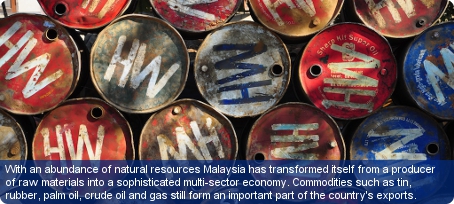Find a business in Malaysia

Blessed with an abundance of natural resources the middle-income country of Malaysia has transformed itself from a producer of raw materials into a sophisticated multi-sector economy in just 25 years. It now has a GNI per capita of US$9,820 (2012) and has seen strong GDP growth rates of 4.3% per annum 2008-12. Its manufacturing sector is one of the economy’s largest and most important, contributing 26% of GDP (2010). Growth has been primarily driven by export-based activities including electronics. But Malaysia could be vulnerable to a fall in commodity prices or a general slowdown in global economic activity, as seen in 2008-09, because of the dominance of exports in its GDP.
From the 1970s, Malaysia achieved phenomenal growth through what economists call “export-oriented industrialisation”, a policy and process aimed at speeding up the industrialisation process of a country through the exportation of goods. Today manufacturing activities are made up of rubber and oil palm processing and manufacturing, electronics, smelting, logging and timber processing. Electronics is one of the major growth industries within the country.
Another important industrial sector is mining and quarrying which contribute around 12% of Malaysia’s GDP (2011). The mining industry of Malaysia has a great history, seeing that the country was the world’s premier producer of tin. However, the industry went through a stagnant period from 2007-10 due partly to a lack of infrastructure.
Although Malaysia’s economy has diversified dramatically, the agriculture, together with forestry and fisheries, sector still contributes 10% of Malaysia’s GDP (2010). Around 6.6ha of the country’s total land area (20%) is designated as agricultural land (2011). The main agricultural products are palm oil, rubber, timber, cocoa, rice, tropical fruit, fish and coconut. Agriculture is split into two sub-sectors: estate and smallholders. The former is a large-scale, commercial style of farming; whilst the latter is more oriented towards food and based in small holdings.
Malaysia has 5.8 billion barrels of proven oil reserves and 2.4 trillion cubic metres of proven natural gas reserves (January, 2011 estimate). The state-owned Petronas dominates the upstream and downstream sectors of the country’s oil industry. It is estimated by the Centre for Public Policy Studies that oil and gas contribute 40% to the government’s total revenue (2008).
As a petroleum exporter, Malaysia has profited from higher world energy prices, although the rising cost of domestic gasoline and diesel fuel has contributed to higher inflation. Malaysia de-linked its currency from the US dollar in 2005. Healthy foreign exchange reserves and a small external debt greatly reduce the risk that Malaysia will experience a financial crisis over the near term similar to the one in 1997; however, it was affected by the global downturn in 2008-09.
To a large extent Malaysia continues to remain dependent on continued growth in the US, China and Japan for its economic wellbeing. These are Malaysia’s top export destinations and key sources of foreign investment.
There are 93,110 km of road in Malaysia, 83% of which are paved. A good network exists in Peninsular Malaysia including a motorway that covers the spine of the region. The country’s express trains are especially modern. Ferry services run between ports on the peninsula and link the peninsula with Sabah and Sarawak. The main airport, Kuala Lumpur International Airport, is located near Sepang.
Malaysia is ranked number one in the world for getting credit and 18th overall for ease of doing business, according to the World Bank’s ‘Doing Business 2012’ study. It is also ranked as the fourth best country in the world for protecting investors. These rankings measure the conduciveness of a regulatory regime in starting and operating a business.
Malaysia has an adult literacy rate of 93.1% (2010) and the majority of the population speaks English; the other official language is Malay. The workforce is highly skilled with up to 13% being professionals, and another 13% employed as technicians and associate professionals.





